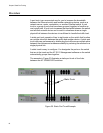
Chapter 6: Static Port Trunking
94
Overview
A port trunk is an economical way for you to increase the bandwidth
between the Ethernet switch and another networking device, such as a
network server, router, workstation, or another Ethernet switch. A port
trunk is a group of ports that have been grouped together to function as
one logical path. A port trunk increases the bandwidth between the switch
and another network device and is useful in situations where a single
physical link between the devices is insufficient to handle the traffic load.
A static port trunk consists of two to eight ports on the switch that function
as a single virtual link between the switch and another device. A static port
trunk improves performance by distributing the traffic across multiple ports
between the devices and enhances reliability by reducing the reliance on a
single physical link.
A static trunk is easy to configure. You designate the ports on the switch
that are in the trunk and the AT-S112 Management software on the switch
automatically groups them together.
The example in Figure 30 illustrates a static port trunk of four links
between two AT-GS950/16PS switches.
Figure 30. Static Port Trunk Example
Static Trunk


















